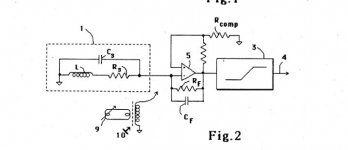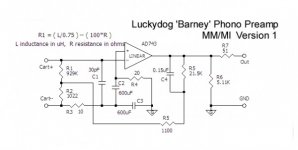Hi Hans,
Finally a few seconds to look at your 'universal' design and have a couple of questions
1. I assume we will still end up with 3 'flavours' of this for 2L-R cartridges, PiL-R and Grado?
2. Is there any benefit in looking at the Meitner approach from his patent. I'm trying to find a cartridge that won't work with this but so far they all appear to be ok. Having a 50hz pole may not have any real advantage but feels right.
The phantom power option looks good BTW. Def something I want to try in the next decade (based on current project rate!)
Finally a few seconds to look at your 'universal' design and have a couple of questions
1. I assume we will still end up with 3 'flavours' of this for 2L-R cartridges, PiL-R and Grado?
2. Is there any benefit in looking at the Meitner approach from his patent. I'm trying to find a cartridge that won't work with this but so far they all appear to be ok. Having a 50hz pole may not have any real advantage but feels right.
The phantom power option looks good BTW. Def something I want to try in the next decade (based on current project rate!)
Attachments
1. I assume we will still end up with 3 'flavours' of this for 2L-R cartridges, PiL-R and Grado?
2. Is there any benefit in looking at the Meitner approach from his patent. I'm trying to find a cartridge that won't work with this but so far they all appear to be ok. Having a 50hz pole may not have any real advantage but feels right.
I see no benefit for the Grado style cart. I get the noise of the 400 Ohm series resistance over the entire audio range and as far as I can tell the frequency response is all mechanical issues.
I wish I had my Jelco arm so I could do some swapping of carts easily. You can't escape the current noise of the TIA feedback resistors.
Last edited:
I've just sold most of my headshells as I realised I'll never run more than one cartridge of an evening. At least for the next decade or so.
2. Is there any benefit in looking at the Meitner approach from his patent.
Magnetic pickup preamplifier
George
I’ll come with an excel spreadsheet. You put in your Cart and excel does the calcalution.Hi Hans,
Finally a few seconds to look at your 'universal' design and have a couple of questions
1. I assume we will still end up with 3 'flavours' of this for 2L-R cartridges, PiL-R and Grado?
2. Is there any benefit in looking at the Meitner approach from his patent. I'm trying to find a cartridge that won't work with this but so far they all appear to be ok. Having a 50hz pole may not have any real advantage but feels right.
The phantom power option looks good BTW. Def something I want to try in the next decade (based on current project rate!)
Point is however that I have no clue how accurate the Cart spec’s are, within 1%, within 10% or what. In a 47k/200pF situation this is a non issue, but the Aurak is extremely sensitive to little variations leading to relativy large deviations in the FR.
Meittner came with an interesting solution, also based on a transimpedance, but its overload margin is smaller, noise is worse and stability might become an issue with the positive feedback, so I see no benefits over the Aurak.
As presented the voltage noise of Rcomp and the current noise of Rf are always there so the SNR is always degraded at the expense of frequency response.
Hans: shame on the Meitner as it had things going for it. Ah well
Ref the accuracy, I may have run the numbers incorrectly, but I found that the sensitivity was relatively low, as in the 318Hz pole would move +/- a few Hz. This would equate to a few 10th of a dB error down low or the same at 10kHz. For me correctable with a simple shelf in DSP so not that bothered, BUT I would like to do some more accurate measurements on the cartridges that I have.
Ref the accuracy, I may have run the numbers incorrectly, but I found that the sensitivity was relatively low, as in the 318Hz pole would move +/- a few Hz. This would equate to a few 10th of a dB error down low or the same at 10kHz. For me correctable with a simple shelf in DSP so not that bothered, BUT I would like to do some more accurate measurements on the cartridges that I have.
1. I assume we will still end up with 3 'flavours' of this for 2L-R cartridges, PiL-R and Grado?
What is PiL-R ?
What is with Grados that makes them a special category?
George
When Hans was helping me with the mods to support my madder MMs (audio technica AT22) we did the calculations as 3.14L-R instead of 3 to give 500Hz pole. Mathematically neater.
Grados are exceedling low Z. So low in fact that a quick rejig gives a 75uS pole with transimpedance loading.
All buried in the mechanical resonance thread 🙂
Grados are exceedling low Z. So low in fact that a quick rejig gives a 75uS pole with transimpedance loading.
All buried in the mechanical resonance thread 🙂
@LD
And the eventual wiring problem was clearly mentioned.
So what exactly did you mean with "not quite , but close".
Hans
This is an exact repeat of what I was telling in the explanation.Not quite, but close...…….!
There is no series 10k or so resistor. Aurak does not directly form the 75uS time constant from the preamp's input impedance and cartridge inductance, but the 1st stage does implement the 75us RIAA pole with a nice trick.
Some people simply prefer a differential version, so it's up to them.IMO the single ended version is fine and performs well. There's no need and not much advantage of a balanced version, which has disadvantage of requiring re-wiring of the headshell/arm. The SE version works with standard wiring and is relatively easy to build and try.
And the eventual wiring problem was clearly mentioned.
So what exactly did you mean with "not quite , but close".
Hans
The single ended version isn't sensitive to cartridge L, R. Tolerates about 10% variation for about 1dB in a gentle way.Aurak is extremely sensitive to little variations leading to relativy large deviations in the FR.
LD
From the outset a few years back, Aurak was a true transimpedance input stage and didn't use a relatively large series resistor to form the 75uS pole as the Barney Oliver preamp did.So what exactly did you mean with "not quite , but close".
LD
I still don’t get it.From the outset a few years back, Aurak was a true transimpedance input stage and didn't use a relatively large series resistor to form the 75uS pole as the Barney Oliver preamp did.
LD
In my explanation I mentioned that that the Aurak as a transimpedance amp went one step further as using a 10k termination resistor.
I understand what Hans is saying as it follows my own journey.
In the beginning there was 47k loading
Some people (Barney Oliver and Bob Cordell to name two) have experimented with lower loads to cause an early roll off, in some implementations giving you the 2kHz pole
Transimpedance is the next step loading the cartridge down to a much lower pole.
In the beginning there was 47k loading
Some people (Barney Oliver and Bob Cordell to name two) have experimented with lower loads to cause an early roll off, in some implementations giving you the 2kHz pole
Transimpedance is the next step loading the cartridge down to a much lower pole.
I understand what Hans is saying as it follows my own journey.
In the beginning there was 47k loading
Some people (Barney Oliver and Bob Cordell to name two) have experimented with lower loads to cause an early roll off, in some implementations giving you the 2kHz pole
Transimpedance is the next step loading the cartridge down to a much lower pole.
Thank you Bill, that was exactly what I tried to communicate.
If I only could tell it as nice as you do 🤗
Hence my comment "close but not quite". As it's intended as a reference, might as well get it right I figure.Thank you Bill, that was exactly what I tried to communicate.
If I only could tell it as nice as you do ��
From your post, the part that needs correction is "One of the tools used for investigation has been the so called Aurak preamp that LD or Luckythedog brought forward. This a phono amp that goes one step further as replacing the 47k termination resistor by a much lower value of ca 10k creating a 75usec pole." In Aurak there is no ca. 10k series resistor creating the 75us pole - that topology is the Barney Oliver et al, definitely not Aurak.
I published a sketch once for an op-amp version of the Barney Oliver preamp, but never built it. It was called "The Barney".
LD
Last edited:
I plan to measure my Clearaudio soon, I did have a nice sounding 2kHz pole design with my old Goldring, but changing cartridge means redesign.
A picture is worth a thousand words. Let me dig out a couple of diagrams from the Bob Cordell Vinyltrak article that Jan kindly allowed me to share. I did start trying to write an article on general adventures in cartridge loading, but every time I thought I had it clear another piece of data came along that made me question everything.
This is what Bill had unearthed and posted in this forum(attachment). I have not saved the original post, I can not find it now, sorryI published a sketch once for an op-amp version of the Barney Oliver preamp, but never built it. It was called "The Barney".
LD
Lucky, Hans has given full credit to your design.
So far you’ve been cryptic on the “why” regarding the calculation details of your Aurak brainchild🙂
George
Attachments
- Status
- Not open for further replies.
- Home
- Source & Line
- Analogue Source
- Cartridge dynamic behaviour

